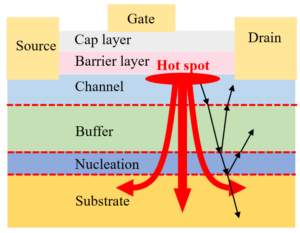 Behind your smartphone screen is a postage-stamp-sized square that contains billions of transistors; the computational power in your pocket dwarfs that of the room-filling computers that heralded the dawn of the digital age. But while advances in materials and fabrication techniques over the intervening decades have enabled computer chips with features measured in individual atoms, the laws of thermodynamics remain stubborn. Maintaining that pace of progress in the design of electronics means figuring out how to get rid of that excess heat before it melts critical components.
Behind your smartphone screen is a postage-stamp-sized square that contains billions of transistors; the computational power in your pocket dwarfs that of the room-filling computers that heralded the dawn of the digital age. But while advances in materials and fabrication techniques over the intervening decades have enabled computer chips with features measured in individual atoms, the laws of thermodynamics remain stubborn. Maintaining that pace of progress in the design of electronics means figuring out how to get rid of that excess heat before it melts critical components.
Tianli Feng, assistant professor in the Department of Mechanical Engineering at the University of Utah’s John and Marcia Price College of Engineering, has received a National Science Foundation (NSF) CAREER Award to advance his research in this area.
Improvements in the design of complex, layered heat transport materials could help cool down electronics in applications that require extremely small sizes, large packing densities, or high power, such as those found in for radar systems, cellphone stations, and various adapters, inverters, and chargers. It will also shed light on the design of thermal protection of turbines, hypersonic aircraft, batteries, and more.
The CAREER Award is part the NSF’s most prestigious support program for early-career faculty, providing a solid foundation for them to develop their research and educational agendas. The award comes with nearly $566K of funding over a 5-year period, which will enable Feng to design simulations, run experiments, hire support staff, train students, and develop materials for educational outreach activities.
Feng’s work is focused on phonons, a representation of atoms’ vibrational energy that can travel through all materials. As “quasiparticles,” phonons are not discrete physical objects, but researchers like Feng treat them as such to make it easier to study their behavior. The sound waves that transmit your voice across a room, for example, are really a chain-reaction of oscillating air molecules that sequentially transfer vibrational energy to their neighbors, but they can also be understood as a collection of phonons that travel from your mouth to a listener’s ear. And because temperature is effectively a measure of vibrational energy, heat transport can also be understood in terms of phonons moving from one place to another. Studying heat transport is equivalent to studying how phonons transport, since materials’ heat transport is determined by atoms in the materials.
Feng’s CAREER-Award-supported research will specifically look at the behavior of phonons as they pass through a series of material interfaces, junctures where those atomic arrangements can radically change.
“My lab discovered that when multiple layers of materials stack together, the total thermal resistance of the multi-layer structure is not the same as the simple summation of all the resistances of those layers and the interfaces between them,” Feng says. “If we can correctly account for the total thermal resistance, we might start producing multi-layer designs in a totally different way than before.”

The composition and spacing of layers, the roughness of their interfaces, the presence of impurities, and several other factors contribute to the currently unpredictable behavior of phonons as they cross material boundaries. To better understand these dynamics, Feng will study them using three theoretical methods: machine-learning-enabled interfacial molecular dynamics simulations, spectral analysis of molecular dynamics, and the Boltzmann transport equation.
“As the lab that first found this problem, we are at the forefront among our peers,” Feng says. “In addition to expanding our unique capabilities in these methods, we will also continue to make free simulation tools for the community of researchers tackling the thermal management problems.
Feng’s work will not only benefit current scientists and engineers; his CAREER Award will support the development of hands-on science kits and lectures for K-12 students in various local communities, research internship opportunities for high school students, and a free online graduate course.